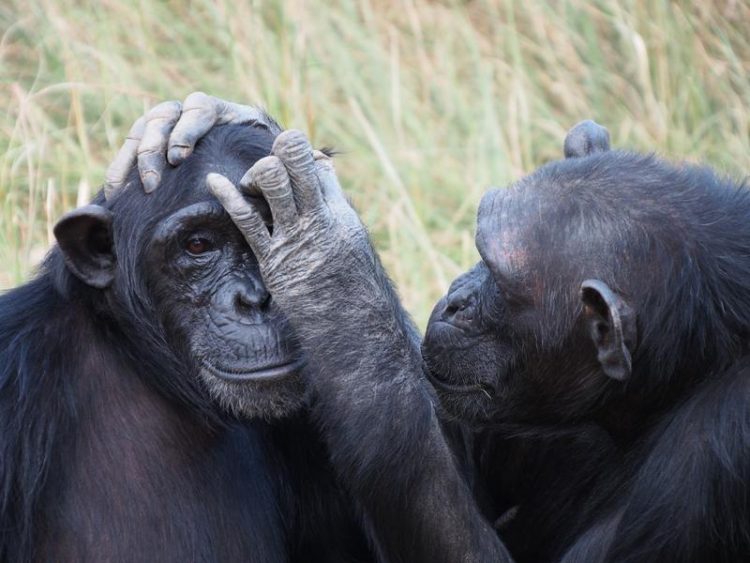Researchers find social cultures in chimpanzees

Fellpflege zweiter Schimpansinnen Foto: Clara Dubois
An international team of scientists including members of the Leipzig Research Center of Early Child Development (LFE) have been studying four groups of chimpanzees at the Chimfunshi wildlife orphanage in northern Zambia over the course of three years.
During this time, they recorded various aspects of their social life such as the number of individuals they spent time with, how close they were to them, and how much they groomed each other. The groups showed the most distinctive difference in the number of individuals they spent time with – i.e. their average party size.
Two of the groups had significantly larger party sizes than the other two groups. “The most gregarious group was also more social in the other aspects we measured”, says senior author and LFE-director Daniel Haun, “the chimpanzees in this group were closer to each other and also groomed each other much more often than the other groups.”
“The set-up of this sanctuary provides us with a unique opportunity to study the origins of chimpanzee culture”, says Sarah DeTroy, a researcher at Chimfunshi and LFE-member. “Usually researchers compare wild groups of chimpanzees that live in different environments and have large genetic differences and therefor can’t rule out the influence of these two factors in the observed differences.
Since the chimpanzees at Chimfunshi all share the same environment and there are no systematic genetic differences between the groups this lets researchers identify how other processes, such as social learning, might create unique chimpanzee cultures.”
“While we didn’t directly investigate the origins of these differences in this current study”, adds Prof Haun, “we know that chimpanzees are able to socially learn from each other and that primates can adapt their social behavior according to their context. The individuals in the respective groups may be observing interaction patterns such as general closeness and grooming frequency and socially learning them.”
The chimpanzee sanctuary, Chimfunshi, is home to over a hundred chimpanzees that have been rescued as well as their offspring. The research team has been working with the chimpanzees at Chimfunshi over the past 10 years studying various aspects of their behavior and cognition, such as their tendency to conform to others’ behavior, the creation and transmission of cultural “fads” and their grieving behavior. “We’ve observed a large variability in chimpanzee behavior over the years we’ve been at Chimfunshi”, says Prof. Haun, “this current study shows some of the extent and stability of differences in general sociability and provides a basis for understanding how these differences could influence other behaviors such as cooperation and prosociality.”
Prof. Dr. Daniel Haun
Institut für Bildungswissenschaften / Frühkindliche Entwicklung und Kultur
Leipziger Forschungszentrum für frühkindliche Entwicklung
Telefon: +49 341 97-31875
E-Mail: daniel.haun@uni-leipzig.de
Web: http://www.lfe.uni-leipzig.de
Sarah DeTroy
Leipziger Forschungszentrum für frühkindliche Entwicklung
Telefon: +49 341 97-31847
E-Mail: sarah.detroy@uni-leipzig.de
“Population-specific social dynamics in chimpanzees”, https://doi.org/10.1073/pnas.1722614115
Media Contact
All latest news from the category: Life Sciences and Chemistry
Articles and reports from the Life Sciences and chemistry area deal with applied and basic research into modern biology, chemistry and human medicine.
Valuable information can be found on a range of life sciences fields including bacteriology, biochemistry, bionics, bioinformatics, biophysics, biotechnology, genetics, geobotany, human biology, marine biology, microbiology, molecular biology, cellular biology, zoology, bioinorganic chemistry, microchemistry and environmental chemistry.
Newest articles

Bringing bio-inspired robots to life
Nebraska researcher Eric Markvicka gets NSF CAREER Award to pursue manufacture of novel materials for soft robotics and stretchable electronics. Engineers are increasingly eager to develop robots that mimic the…

Bella moths use poison to attract mates
Scientists are closer to finding out how. Pyrrolizidine alkaloids are as bitter and toxic as they are hard to pronounce. They’re produced by several different types of plants and are…

AI tool creates ‘synthetic’ images of cells
…for enhanced microscopy analysis. Observing individual cells through microscopes can reveal a range of important cell biological phenomena that frequently play a role in human diseases, but the process of…





















